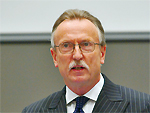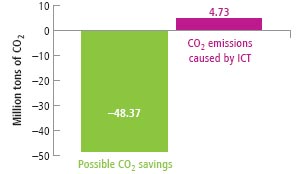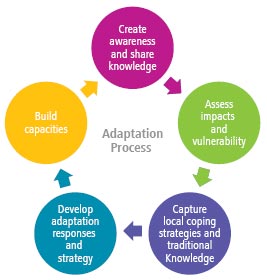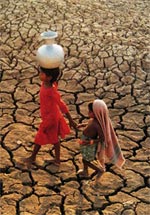|
 Kyoto meeting examines ICT and climate change Kyoto meeting examines ICT and climate change

Nikkei Inc
|
|
“ICT offer a ray of hope and are expected to contribute to addressing the problems of global warming… At the same time, however, it is necessary to consider the impact on global warming from higher electric power consumption caused by the increased use of ICT
devices and their advanced functions.”
Satoshi Ninoyu, Japan’s Vice-Minister for Internal Affairs
|
In December 1997, at a meeting in Kyoto, Japan, the world took practical steps to combat global warming by adding the Kyoto Protocol to the United Nations Framework Convention on Climate Change. So it was appropriate that the city was the venue for a Symposium on ICT and Climate Change, held by ITU and Japan’s Ministry of Internal Affairs and Communications (MIC) on 15–16 April 2008, and organized by the ITU Association of Japan. The symposium was chaired by Takashi Hanazawa, Senior Vice President, Director R&D Planning Department, NTT. There were some 260 participants, drawn from the private sector and a wide range of organizations including research institutes, international organizations and governments.
“Global warming affects everyone on this planet and, for this reason, international responses are needed,” said Japan’s Vice-Minister for Internal Affairs and Communications Satoshi Ninoyu in his welcoming address. “It is in this dire situation that information and communication technologies (ICT) offer a ray of hope and are expected to contribute to addressing the problems of global warming by reducing traffic volumes and increasing the efficiency of production, logistics, and consumption.”

Nikkei Inc
|
|
“In this symposium, we have generated a rich source of ideas of how the ICT
sector can contribute to a greener world, without impacting
negatively on global growth and prosperity.”
Malcolm Johnson, Director of ITU’s Telecommunication
Standardization Bureau (TSB)
|
In a keynote speech, Malcolm Johnson, the Director of ITU’s Telecommunication Standardization Bureau (TSB), stressed that “it is now clear that it is humanity’s use of technology — primarily for generating energy — that is the principal cause of climate change”. However, he added, “technology serves a second important purpose — for generating information — which is now overtaking that first task of generating energy, and it is here that our future hope lies.” Mr Johnson also outlined ITU’s strategy in developing a coherent programme to help tackle the issue.
Energy and ICT
How much assistance ICT can give in reducing greenhouse gas emissions was the subject of a report issued just a few days before the symposium by an MIC “Study group on ICT in response to global warming”. Tetsuo Yamakawa, Director-General, International Affairs Department, Telecommunications Bureau, MIC, explained that in Japan, “in 2012, 30 million tons of CO2 are expected to be emitted in the ICT field, but the use of ICT
will produce CO2 reduction effects of 68 million
tons, contributing to a CO2 emissions reduction of 38 million tons.”
The potential effects of using ICT were also described by Professor Jun Fujimoto of the University of Tokyo’s Research Centre for Advanced Science and Technology. By 2020, he said, using ICT
could reduce CO2 emissions by 2 to 3 per cent, rising to 10 per cent by 2050 — or even higher. Gareth Johnston, Director of Corporate and Government Risk, Climate Risk Pty Ltd (Australia), referred to a study commissioned by Telstra, Australia’s incumbent telecommunication operator. It says that, by using ICT, 27 million tonnes
of CO2 emissions could be saved in Australia, or about 5 per cent of the national total.
|
Figure 1 — Potential influence of ICT on CO2 emissions by ETNO members up to 2010

|
|
Source: Luis Neves, GeSI.
|
Similar observations were made by Luis Neves, Head of Sustainable Development and Environment, Deutsche Telekom (Germany), and Chairman of the Global e-Sustainability Initiative (GeSI). He showed that, in the period up to 2010, the savings that could be achieved by members of the European Telecommunications Network Operators’ Association (ETNO)
exceed by tenfold their current CO2 emissions (see Figure 1). This was echoed by Hans-Otto Scheck, Senior Specialist, Nokia Siemens Networks (Finland), who said that for 15 of the European Union member States, the savings are estimated at 50 million tonnes
of CO2 by 2010, equivalent to 100 terawatt hours of electricity worth some EUR 7 billion.
The role of industry
What can ICT manufacturers and service providers do to reduce their own carbon footprint? A session of the symposium looked at companies that are moving towards a carbon-neutral ICT sector.
Mitsuo Kobayashi, Manager of Corporate Environment Affairs, Asia-Pacific, IBM (Japan), was a member of the team contributing to the original Kyoto Protocol conference in 1997, while working for MIC. He said that between 1990 and 2006, IBM avoided approximately 3 million tonnes
of CO2 emissions through the use of renewable energy and flexible working patterns. Among examples of IBM’s work, Mr Kobayashi cited improved efficiency in data centres, which are major consumers of energy.
|
Videoconferencing
Companies can reduce greenhouse gas emissions by holding meetings through videoconferencing. Yoshiki Kawakami, Director of Enterprise Operations, CISCO Japan, said the firm has committed itself to reducing business travel by 10 per cent and to earmarking some USD 20 million for development of tools for remote working. Jeff Hurmuses, President, China and Japan, Tandberg (Norway), described five case studies of the savings that could be achieved. For instance, the Swedish Customs Service holds 60 videoconferences per month, making a monthly saving of 7 tonnes in CO2 emissions. |
Data centres are one of the main business fields of Hitachi Ltd, Japan, and the company’s vision on this issue was outlined by Tetsuo Takemura, Corporate Officer, Global Business, Information and Telecommunication Systems. He said that Hitachi plans to use a combination of measures to reduce power requirements, including better design and reform in working practices. It should be possible to cut energy consumption by some 22 per cent in the entire life cycle of a product, with almost a one-third reduction at the usage stage.
From Japan’s largest telecommunications provider, NTT, Associate Senior Vice President Hiromichi Shinohara described how the group wants to help meet environmental targets through promoting broadband services. Mr
Shinohara said that, according to NTT research, a 57-per-cent
cut in CO2 emissions can be achieved by multiple Internet subscribers sharing a fibre-optic cable. A similar saving is made by using such a connection to download music and films, compared with buying manufactured goods that have been transported to a shop.
Fixed and mobile networks are heading for convergence in Japan, said Yutaka Yasuda, Vice President, General Manager of Core Technology Sector, at the Japanese telecommunication operator KDDI. He described the company’s energy conservation efforts, which include introduction of high-efficiency mobile base stations, the use of solar power, and development of next-generation battery technology. KDDI is targeting a 16-per-cent reduction in energy usage by 2011 and a limit of 1.5 million tons of greenhouse gas emissions.
Striking a different note, Joanna Gordon, from the IT Industries Team of the World Economic Forum (WEF), Switzerland, argued that although the ICT sector had embraced the challenge of climate change, companies are pulling in different directions. She said that the sector “is spending 98 per cent of its time discussing 2 per cent of the problem” (that is, its own emissions), while missing the opportunity offered by the use of ICT to reduce greenhouse gas emissions in other sectors. Change will come about through financial incentives, Ms Gordon said, adding that WEF had issued a challenge to its partners and governments to establish a list of economically viable approaches, develop a clear message and create incentives for change.
|
Monitoring the climate
The role of ICT in monitoring and modeling climate change was discussed by several speakers at the symposium, including Makoto Kaji, Associate Executive Director at the Japan Aerospace Exploration Agency (JAXA). He highlighted the role that remote Earth observation from satellites can play in assisting with the adaptation process. For example, he said, during the 2008 financial year JAXA will launch the Greenhouse Gases Observing Satellite (GOSAT) which will extend the number of sampling points from the current 256 to some 56 000 worldwide. |
A call to ITU–T
Standardization is an important component of ITU’s work relating to climate change, and a number of speakers at the symposium called on the Telecommunication Standardization Sector (ITU–T) to focus efforts in this area. For example, Mr Yamakawa, of MIC, said the report just issued by a ministry study group contained recommendations for areas in which ITU work could be important, including standardization, establishing ways to measure how ICT is reducing greenhouse gas emissions, and in assisting developing countries.
Yuji Inoue, President and CEO, Telecommunication Technology Committee of Japan, explained that Japanese companies have been developing a harmonized method for assessing emissions at a national level, under a Task Force coordinated by the Committee and MIC. However, he said, such a methodology needs to be adopted at the international level. He proposed a series of roles that ITU–T could play in achieving this, through establishing a Focus Group that would bring together standardization and climate change experts, including non-members of ITU.
Already, an “Energy Efficiency Checklist” has been produced to provide for a systematic review of existing and new ITU–T Recommendations, explained David Faulkner, of the United Kingdom operator BT and Rapporteur for ITU–T Study Group 15 (Question 2). The number of broadband users keeps growing, and, on average, transmission capacity tends to double every year or so. This means that power requirements also double. “The challenge, therefore, is to develop standards that break that linear relationship and allow transmission capacity to rise while power consumption falls,” Mr Faulkner said.
Adapting to climate change
The science of climate change is made possible by the use of ICT, for instance in remote sensing and in using supercomputers for climate modelling (see articles
Global Forum
examines the role of telecommunications and ICT in disaster
management in the December 2007 and
ICT and climate
change January–February 2008 issues of ITU News). In addition to discussing the tools that are available for monitoring, the symposium also looked at ways in which ICT can help communities adapt to climate change.
|
Figure 2 —
Five phases of adapting to climate change

|
|
Source: Sangeeta Gupta, Energy and Resources Institute, India.
|
There are five main phases of adaptation (see
Figure 2), said Sangeeta Gupta, Director IT, Energy and Resources Institute, India. She highlighted three areas — agriculture, water and health — in which ICT could have an impact through such methods as integrated natural resource management, monitoring, disaster response and relief systems, and capacity building and education. Ms Gupta described a pilot project of the Institute for developing an information-sharing system to help farming communities in drought-prone areas of northern India.
Focusing on communities high in the Himalayas, Mahabir Pun, of Nepal and Chairman of the Institute for Himalayan Conservation, gave a presentation on “Disaster prevention monitoring in a vulnerable environment”. He described a project to develop a wireless sensor network at the Imja-Tse glacial lake — one of more than 20 such lakes in Nepal which, if they overflow as glaciers melt, could endanger many lives. The project is being conducted in cooperation with Keio University, in Tokyo, Japan, and aims to provide early warnings through Wi-Fi-based local area wireless networks in several villages, with a very small aperture terminal (VSAT) satellite connection to the Internet.
 © A. Ishokon/UNEP/
© A. Ishokon/UNEP/
Still Pictures
Using ICT to share information could help communities in, for example, drought-prone areas of India, to adapt to climate change
|
Work ahead
The conclusions of the symposium were listed in a Chairman’s report produced by Mr Hanazawa. Among these, it notes that in order to promote the use of ICT
to combat climate change, there is a need for “the establishment
of common approaches at the international level to evaluate CO2 emissions, and the development of policies to create an appropriate incentive mechanism”. It adds that as well as improving awareness among individual ICT users, “there is also a corporate responsibility to achieve a climate-neutral status, in which public-private partnership is essential”.
London meeting
The second ITU Symposium on ICT and Climate Change took place on 17–18 June 2008 in London, United Kingdom, hosted by BT.
|
The report states that “ITU should take the initiatives that may be required for energy-saving systems and applications where there is a requirement for standardization”. Also, ITU should assist countries, particularly developing ones, and should show how ICT can help in preparing for and withstanding the effects of climate change.
TSB Director Malcolm Johnson said that ITU will study seriously the Chairman’s report when considering future strategy. He added that he had taken particular note of the call for action in ITU–T, and he fully supported the meeting’s recommendation that an ITU–T Focus Group should take the work forward. He said he would make this proposal to ITU’s Telecommunication Standardization Advisory Group (TSAG) at its next meeting in July 2008.
Mr Johnson noted that the symposium had clearly pointed to the need for an internationally agreed, common methodology for measuring the direct and indirect effects of ICT on climate change. “I believe this is important and urgent work. It needs to be carried out in an open, rigorous and multidisciplinary way. It needs to involve not only the whole ITU membership, but also the work of non-members,” he said.
Full details of the symposium can be found online at
www.itu.int/ITU-T/worksem/climatechange/index.html. Videos of the presentations are available at:
www.itu.int/themes/climate/videos/index.html
|


